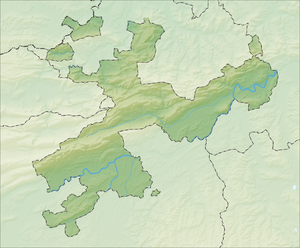Sternenberg ruin
| Sternenberg ruin | ||
|---|---|---|
|
Sternenberg ruin from the south (2009) |
||
| Creation time : | Mid 13th century | |
| Castle type : | Hilltop castle | |
| Conservation status: | ruin | |
| Standing position : | Men's | |
| Place: | Hofstetten-Flüh | |
| Geographical location | 47 ° 28 '42.6 " N , 7 ° 30' 17.8" O | |
| Height: | 468 m above sea level M. | |
|
|
||
The Sternenberg ruins are the ruins of a small feudal castle in the municipality of Hofstetten-Flüh in the canton of Solothurn .
location
The ruin of the hilltop castle lies at 468 m above sea level. M. in the forest on the edge of the plain west of the Hofstetten district, above the Flüh district, on the edge of the valley south of the road between Hofstetten and Flüh. It was built on a natural rock head that lies on the northern edge of the plain west of Hofstetten. The system was cleared of the forest in 2008 and the access routes in the south (from the high plateau) and north (from the valley floor) were renewed and provided with steps. This means that the ruins are easily accessible again for hikers.
investment
In front of the stone castle, which can still be seen today, there was a wooden castle on the rock head since around 1200. However, this can only be proven stratigraphically . This previous building was replaced in the 13th century by a stone castle, which was made of little hewn limestone.
Access to the fortress was (and still is) from the south-eastern end of the rock head. On the east side of the complex there was a narrow side gate next to the house (probably in the usual form of a residential tower ), which leads into the north-facing courtyard: the steps carved into the limestone cliffs are still visible and accessible today. The castle consisted of a permanent house, the bulging, up to 3.55 meter thick shield wall of which adjoins the southern front of the moat. There is a courtyard to the west of the house, which is also located south of the cistern room . Both can be reached from the courtyard via stairs carved out of the rock. The fortress was supplied with water from the filter cistern and from the nearby stream.
history
The whole area was ruled by the Rotbergers and so it can be assumed that the Bishop of Basel and the Counts of Thierstein tried to slow down the Rotberg's expansion of power with this rule. By building the castle on allodial cleared land, a judicial system independent of the Rotbergers could be established. The Thiersteiners received the fortress and the associated rights as an inheritance from the bishop, probably because they had financed the construction. But they passed this rule on as an after-fief to the noblemen of Hofstetten, the gentlemen of Roseck, the Eptinger von Wildenstein and finally to the Schaler von Leimen.
The castle was inhabited by the lords of Hofstetten from the middle of the 13th century to the first half of the 15th century. The remains of the wall that can be seen today go back to a building from the end of the 13th century, which was built over a previous wooden building. At the end of the 14th century, the castle was redesigned (probably Hug Fröwler, husband of Agnes von Hofstetten), which could be proven by archaeological finds. Around the time of the St. Jakober War (1444), the castle was devastated by a conflagration: Due to the poor sources, it is not clear whether the fire was the result of armed conflicts. On September 15, 1525 the inheritance of Margaretha (widow of the last Thiersteiner) is sold to the city of Basel. The city sells the entire complex with all rights to Solothurn in 1529 at the latest.
Part of the ruin was demolished in 1852 and the stones were used to build roads. The ruin was excavated and preserved in 1959/60. During the explorations for the restoration in 1953, the remains of a splendid dome stove, the construction of which is dated to around 1400 (redesign of the castle): The slab tiles brought to light show heraldic animals in bas-relief. In 2008 the castle was awakened from its deep slumber by clearing the forest and renewing the paths.
In autumn 2009 the municipality decided not to start renovating the ruins for financial reasons.
literature
- Werner Meyer : Castles from A to Z - Burgenlexikon der Regio . Published by the Castle Friends of both Basels on the occasion of their 50th anniversary. Klingental printing works, Basel 1981, pp. 221–222.
- Gottlieb Loertscher: The districts of Thal, Thierstein and Dorneck . In: The art monuments of the Canton of Solothurn . Birkhäuser, Basel 1957, Volume 3, pp. 335–336.
- Bruno Amiet : The castles and palaces of the Canton of Solothurn . Birkhäuser, Basel 1930.
- Emanuel Büchel : Sternenberg . 1746, public art collection in Basel.


